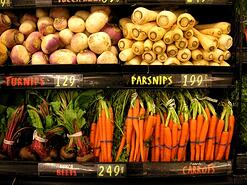It’s simple really; if you don’t let poor food options into your house the likelihood of making poor dietary choices goes way down. That is why your weekly visit to the grocery store is so important. It is where you have the opportunity to open the door to nutritious foods and close it to unhealthy options.
As we talked about in my previous blog, healthy eating doesn’t have to be hard. Having the right ingredients on hand makes it so much easier to whip up simple healthy snacks and or meals. Generally speaking, what you want are things that are fresh whole foods, items with very little added sugar and sodium, low in saturated fats, and free of trans fats. Here are some simple tips on how to load your refrigerator and pantry with nutritious ammunition so you can pull the trigger on healthy eating in a snap.
- When you visit the grocery store shop the perimeter. This is primarily where all the fresh lean cuts of meat, low fat dairy, and fresh produce are located. When you start venturing towards the center of the store you hit all the processed foods aisles that are typically sodium, preservatives, and trans fats because it is these items that must remain shelf stable.
- Look for fresh or frozen fruits and vegetables in a wide array of colors. If you decide to go with canned produce choose low sodium veggies and fruits that are canned in their own juice or water as opposed to syrups to avoid added sugar and calories. When choosing your frozen veggies keep an eye out for the hidden fat, sodium, and other additives that can be found in packages which also contain a sauce or marinade.

To cook fresh veggies, use such methods as microwaving, steaming, roasting, or grilling to cook your veggies instead of boiling which leaches nutrients out of the veggies and into the water. If you do decide to boil, save the nutrient rich water to use as broth for soups or as the base for a sauce. If you are in a hurry, no fear! You can still easily work some veggies into your meals. Often times the simplest cooking method – steaming in the microwave- is the best way to preserve nutrient content of vegetables because it reduces cooking time. One of my favorite things to do is pop a frozen veggie medley into the microwave to steam then season it as a quick, delicious and healthy side, or include it in the main dish by adding it to a stir fry or pasta dish.
- Avoid the temptation lurking in the snack aisle. Only go through the aisles in which you know you need something. Look for healthy and easy meal options like packets of oatmeal for breakfast with little to no added sugars (my favorite brand is Better Oats), peanut butter to pair with some whole grain toast or crackers, or dry roasted unsalted nuts such as almonds or walnuts for a nutritious and satisfying snack option. Stay away from snacks that make you want to wipe the grease off your hands after eating! That is a sure sign of an unhealthy option!
- When it comes to grains, make sure they are in fact 100% whole grain! Whole grain label claims can be difficult to decipher, but you can always rely on the ingredients list. If a grain is listed with the word ‘whole’ in front of it you can be assured that the ingredient is a whole grain. Ingredients are listed in descending order of predominance. What this means is the first ingredients listed are the ones that make up most of the product.

If you see “wheat flour” or “white flour” as one of the first ingredients listed the product may be primarily refined grains. Make the simple switch to whole grain bread, pasta, or other grains such as brown rice or quinoa. This is about the easiest switch you can make to decrease your risk for disease and improve your overall health.
- Farmer’s Markets or coops are a great alternative to the grocery store and an absolutely fun way to support local producers, reinforce a sense of community all the while increasing fruit and vegetable intake and avoiding the added preservatives, sodium, sugar, fat, and trans fats that are often found in processed foods. They often times introduce you to new produce you may have never tried before and they always instill a sense of farm to table increasing the appreciation of the food cycle.
- Instead of buying sodium packed spice blends or marinades, make your own by experimenting with fresh or dried herbs and spices which will allow you to make fun flavorful dishes without all the sodium and additives.
- Most importantly, never shop on an empty stomach. When you’re hungry everything sounds good and we as humans are hard wired to go for high calorie highly satisfying foods when we’re hungry. So guess what happens when you shop when you’re starving? Exactly—your cart is full of not-so-good choices which set the stage for a poor diet until your next shopping trip.

What are your favorite ingredients to shop for? Check out my next blog for healthy easy recipes!
Photo Credits:
Grocery shopping: USACE Europe District via photopin
Vegetables: blmurch via photopin cc cc




